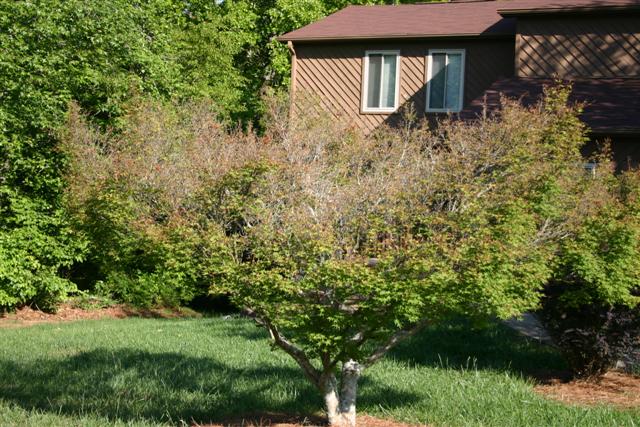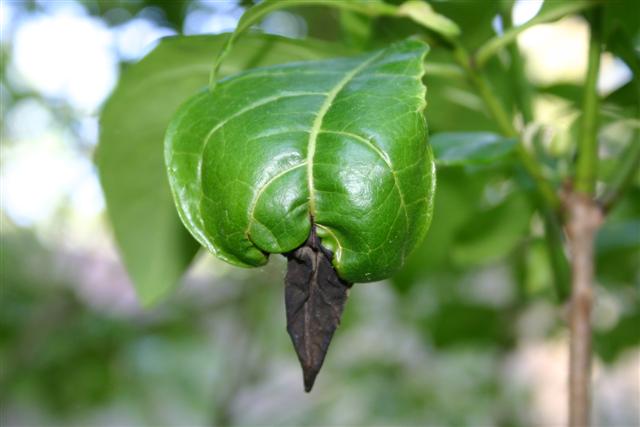Ask An Arborist: March 4, 2010

|

|
|
Japanese Maple: 2007 |
Fringe Tree: 2007 |
Winter damage to trees can be caused by several factors and be evident at different times of the year. These can be immediately
noticeable as with physical damage caused by snow and ice or they can be more subtle and not appear until some time during
the next growing season. Because the winter this year has been different, be prepared to see signs of damage as we enter this
upcoming spring and summer.
Winter damage isn't just a factor of how cold temperatures become or how much it snows. It's also a factor of the duration and
timing of cold weather.
Record low temperatures at any time of the winter can cause damage to trees, especially those that are
growing where they are marginally hardy. If these temperatures last for several hours or reach record lows for several
consecutive days, you could get damage to dormant buds. This won't be noticed until spring.
To paraphrase a quote I heard at a lecture given by someone I can't remember with reference to the cold hardiness and
endurance of plants: It's easy to run naked through the freezer without harm but try sitting all day in the refrigerator.
Early frosts can catch trees off guard before they have completed their winter preparations. This year in Montana, I eagerly
awaited the golden yellow of the aspens, something I had never seen firsthand. Temperatures in September were unusually warm
in Montana. We reached an official high of 85 degrees on September 29. It snowed on September 30 and on October 2, the official
low was 28 degrees - much colder in certain mountain areas. It remained cold for several days in a row.
The result was the still-green leaves of the aspens eventually turned to a
lovely shade of toast. The cottonwood leaves fell from the trees and the streets were littered with green leaves.
I was not going to see the golden aspens this year. Usually early frosts don't do much permanent damage
as new growth has already hardened off and leaves on deciduous trees are losing vigor.
Repeated freeze-thaw cycles caused by below freezing temperatures during the night or over several days followed by above
freezing temperatures can cause fractures in the trunks and limbs of some trees. I have seen this problem on maples, cherries
and other trees with thin bark. Wrapping the trunks of susceptible trees, especially those young or newly planted can help
prevent this.
By far the worst danger for trees and winter damage is caused by late frosts/record lows especially if preceded by what is
often called a "false spring." If you lived in Georgia in March of 1993, you know what I mean. Temperatures in the first week of
that month broke 70 degrees. On March 13, a snowstorm hit Atlanta and temperatures dropped into the teens to low 20s. Trees that
had been tricked out of dormancy and were in bloom such as okame cherries, bradford pears and saucer magnolias lost all of their
flowers. Some had significant dieback at the terminal ends of branches. Leaf buds were also damaged.
More recently, the Easter weekend freeze of 2007 (April 7-9) sent temperatures into the 20s, teens in the northern parts of the
state. Trees that were already leafing out
lost their entire first coat of leaves. I drove through Clayton around May 1 and it looked like January. The deciduous
trees were completely bare. That year I saw significant branch dieback in Japanese maples and crape myrtles. Even my native
fringe tree had damage to the tips of its leaves. Oaks, pecans and hickories were in bloom, so their nut production was limited.
Fruit trees really took it on the chin - major damage was done to the peach crop. On a more positive note, that severe frost
hit when the sweetgums were in bloom and practically eliminated the entire crop of gumballs that year. Obviously March and
early April are particularly vulnerable times for trees. Most are beginning to show signs of life. Be prepared, if feasible,
to protect the buds or tender new growth should temperatures drop below freezing.
Care for Winter Damaged Trees
Remove limbs broken by snow or ice as soon as possible. Do not use sealants on tree wounds caused by breakage or pruning. Let the
tree wall off the damage itself. If you suspect that may have dieback caused by extreme cold, put the pruners away until later in
the season. I've often been quoted as saying that nothing is dead until it's warm and dead. If parts of your tree don't leaf out
with the rest of the tree or you have no foliage by early May (barring any really late freezes), get out the pruners or
chainsaw. Fertilize your trees with a slow-release fertilizer in May. Avoid high nitrogen fertilizers past mid/late summer to
reduce the chances of a late season flush that won't harden off in time. This also applies to pruning. As always, make sure there
is an adequate (2-3 inches) layer of mulch to protect tree roots from wide swings in temperature and moisture.
Please email me if you have any questions or topics you would like to submit
for later articles.
If you are concerned about the trees in your landscape, you can contact a Certified Arborist or a professional tree company in
your area through the web site of the
Georgia Arborist Association.
Unless otherwise noted, Images & Drawings Copyrighted © 2010 by Theresa Schrum - All rights reserved
Please see my
Image Use Policy.



